How to Wear a Dirndl? Step-by-Step Guide to Styling It Right

How to Wear a Dirndl?
Wearing a dirndl is more than just putting on a dress — it’s about embracing tradition with style. From choosing the right fit to tying the apron bow with meaning, every step reflects cultural charm and personal expression. This guide walks you through each detail, from bodice adjustments to optional accessories, so you can wear your dirndl confidently and authentically. Whether it’s your first time or you’re refining your look, you’ll find everything you need to know right here.
Start with the Right Undergarments
When wearing a dirndl, the right undergarments are essential for both comfort and style. Start with a seamless bra or a push-up bra for lift and support. These will help create a smooth look under the dress, especially with fitted tops. A seamless bra is perfect if you’re aiming for a more natural shape, while a push-up bra adds a bit of extra lift if desired.

If you want to add more volume to the skirt of your dirndl, consider wearing a petticoat. Petticoats can help create that classic flared look, giving your dirndl a fuller appearance. Shapewear is another option for smoothing out your figure, providing a more streamlined silhouette.
For extra coverage or modesty, you can also add a slip under your dirndl. A slip can help ensure that the dress sits comfortably and gives an added layer, while also helping the skirt maintain its shape. Whether for volume, smoothness, or modesty, these undergarments help enhance your overall look while ensuring you feel comfortable and confident in your dirndl.
How to Buy a Dirndl
Blouse Comes First
Choosing the right blouse is the first step in styling a dirndl. There are several styles to pick from—square necklines offer a classic, flattering look, while high collars bring a touch of elegance. Lace or off-shoulder blouses can add a bit of romance or playfulness depending on the occasion. No matter the style, the fit is key: your dirndl blouse should be snug at the bust and cropped just under the bustline to sit perfectly beneath the dress. When it comes to styling, aim for a neckline that stays visible but tasteful—striking the perfect balance between traditional and chic.
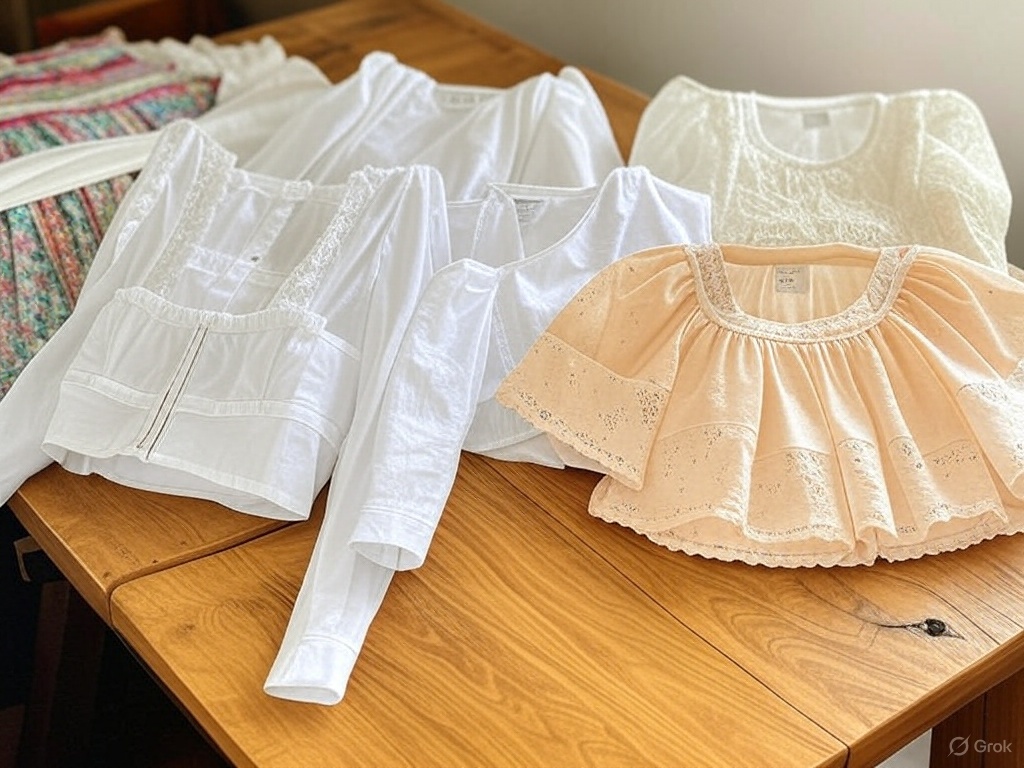
Types of Dirndl Blouses (Square Neck, High Collar, Lace, Off-Shoulder)
Choosing the right type of blouse is the first and most important step when styling your dirndl. Each blouse type brings a different personality and vibe to your outfit:
- Square Neck Blouse: This is one of the most popular and versatile styles. It works well with most dirndl cuts and shows off the neckline in a flattering way, ideal for accessorizing with a delicate necklace or a choker.
- High Collar Blouse: If you’re aiming for a more classic or vintage Bavarian look, a high-collared blouse adds sophistication. It’s perfect for cooler weather or more formal settings where modesty is preferred.
- Lace Blouse: For a romantic and feminine feel, a lace dirndl blouse adds intricate detail and elegance. Whether full lace or lace sleeves, this option pairs beautifully with solid-colored or richly embroidered dirndls.
- Off-Shoulder Blouse: Great for a fun, flirty look, especially at festivals like Oktoberfest. Off-shoulder styles show a little more skin while still keeping things traditional. They’re a modern take on the classic dirndl silhouette.
Each style can be mixed and matched with different dirndls to create a personalized and authentic Bavarian look, depending on the occasion and your comfort level.
Proper Fit: Snug at the Bust, Cropped Under the Bustline
Fit is everything when it comes to dirndl blouses—it’s not just about style, it’s about structure. A proper dirndl blouse should fit snugly around the bust, offering a gentle lift and definition without feeling too tight. The goal is to enhance the shape created by the dirndl bodice, not to flatten or over-emphasize.
How to Make a Dirndl Dress
Most dirndl blouses are cropped to sit just below the bustline, which prevents bulk under the bodice and keeps the silhouette neat and tailored. This cropped design also allows for better airflow, making the blouse more comfortable during long events or warmer days.
If the blouse is too loose, it can bunch up under your dirndl and disrupt the sleek look. If it’s too tight, it can be uncomfortable and unflattering. A fitted blouse should feel supportive, almost like a soft undergarment, blending function and fashion for a seamless fit under your dress.
Styling Tip: Keep Neckline Visible but Tasteful
The neckline of your dirndl blouse plays a subtle yet important role in balancing elegance with tradition. Whether you’re dressing for a festival or a formal occasion, showing the right amount of neckline can completely change your look.
The key is to let the neckline show just enough—it adds charm and shapes your outfit without drawing too much attention. For example, square necklines naturally enhance the bust line and pair well with shorter necklaces or traditional chokers (Kropfbänder). Meanwhile, lace or sheer overlays can make a modest neckline feel more delicate and stylish.
Avoid necklines that are overly plunging or distracting, especially for family gatherings or traditional festivals. If you’re going for a bolder look, balance it out with more conservative accessories or a cardigan. A tasteful neckline keeps the outfit flattering and feminine while honoring the cultural roots of the dirndl.
Step into the Dirndl Dress
Adjust Bodice Snugly to the Waist
The bodice is the foundation of any dirndl dress, and getting the fit right is essential for both comfort and style. A properly fitted bodice should hug your waist closely without being too tight. This close fit helps shape the silhouette and creates that signature dirndl look.
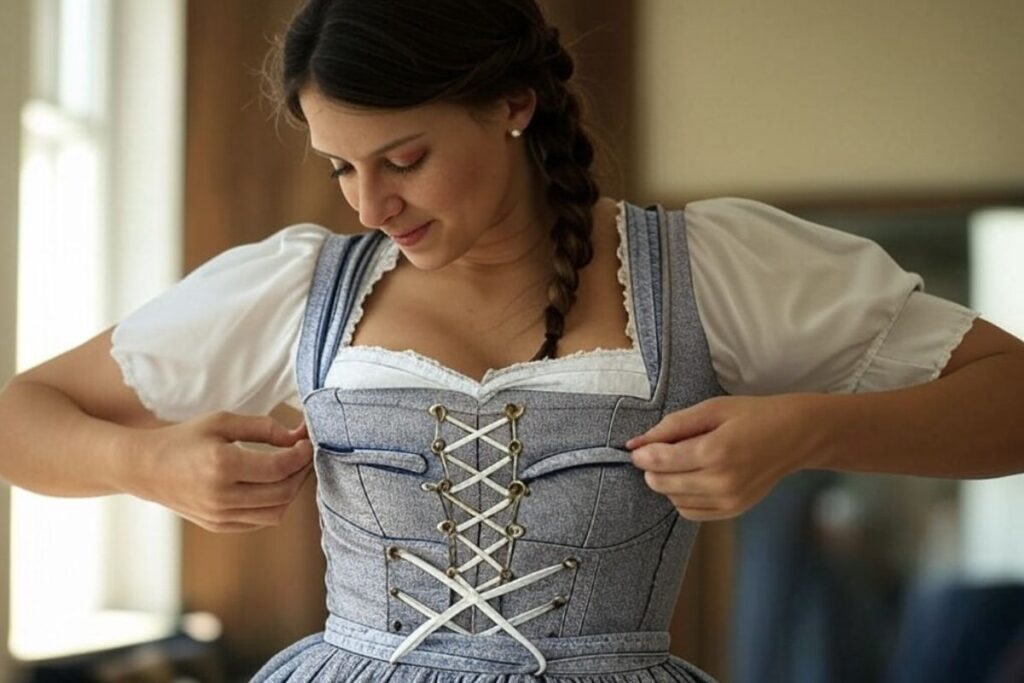
To adjust it properly, make sure the bodice lays flat against your body, especially around the waist and underbust area. You might find that some dirndls come with lace-up detailing, which allows for small adjustments. Others may rely on their cut and structure for shaping. Either way, the goal is to have a snug fit that feels secure but doesn’t restrict your breathing or movement.
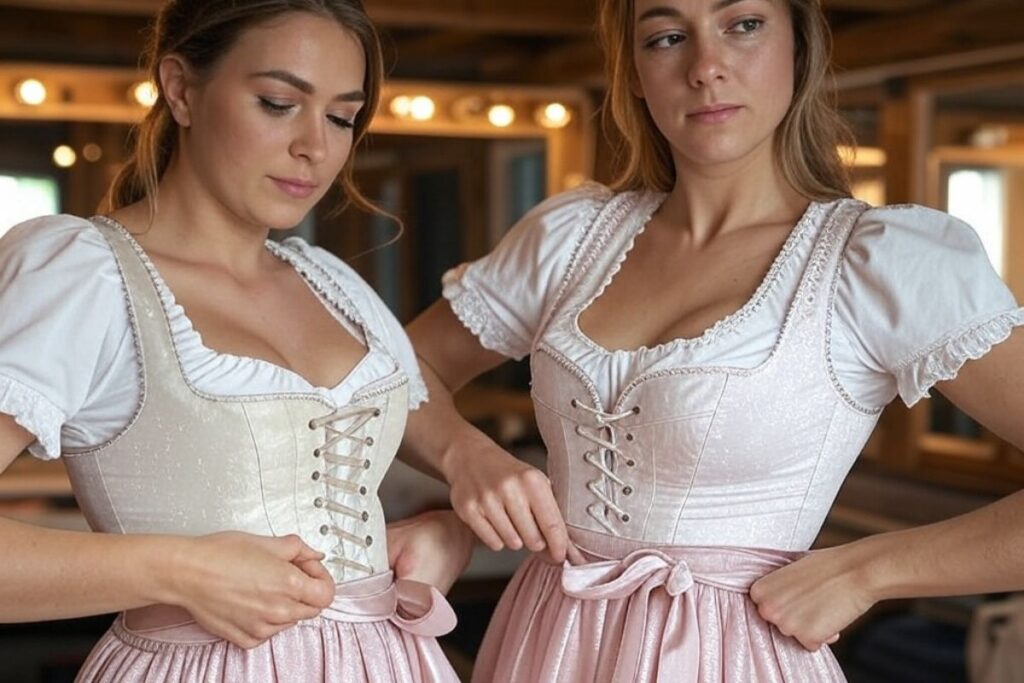
A well-fitted bodice not only supports your bust but also defines your waistline—enhancing that hourglass shape traditional dirndls are known for.
Fasten Side Zip or Front Buttons
Dirndl dresses come with two common fastening options: side zippers or front buttons. Each style offers a different aesthetic and function, but both are deeply rooted in traditional design.
- Side Zip: Most modern dirndls use a discreet side zipper that’s easy to use and helps keep the front of the dress smooth and uninterrupted. It’s great for quick wear and often hidden beneath the arm or side seams.
- Front Buttons: This style adds a more vintage or rustic touch to your outfit. It can be functional or decorative, depending on the dress. Button-front dirndls tend to be slightly more adjustable in fit and give a charming, classic look.
Regardless of which closure your dirndl has, make sure it’s secure and aligns perfectly. A misaligned zip or loose buttons can ruin the sleek, tailored appearance of the bodice.
Bodice Should Contour, Not Pinch
A dirndl should never feel like it’s squeezing you—supportive, yes; uncomfortable, no. While it’s meant to follow your body’s shape, the bodice should contour gently without digging into your ribs or pinching your skin.
Look for a balance between structure and softness. The fabric should be sturdy enough to provide shape but have enough give to move with you. If you feel like the dress is limiting your range of motion, it may be a sign the fit is off.
When trying on a dirndl, sit, stand, and move around. A good fit means you should feel supported and confident, not restricted or stiff. Keep in mind that you’ll likely wear it for hours—especially at events—so comfort is just as important as looks.
Skirt Should Hit Just Below or Above the Knees (Depending on Style)
The skirt length of a dirndl is more than just a style choice—it also reflects tradition and occasion. While there’s no strict rule, the ideal skirt length typically falls just above or just below the knees.
- Above the Knee: Shorter dirndls are often worn at festivals like Oktoberfest or by younger women looking for a playful, modern style. They’re light, breezy, and great for dancing.
- Below the Knee: This is the more traditional and formal look. A midi or tea-length dirndl (falling below the knee or mid-calf) is considered elegant and works well for church visits, family celebrations, or cultural events.
Lace the Bodice (if needed)
Lacing Methods: Inside-Out vs Crisscross
When your dirndl comes with a lace-up front, the way you thread the ribbon or chain can influence not just the look, but also the overall fit and comfort. The two most common lacing methods are crisscross and inside-out, both with their own appeal.
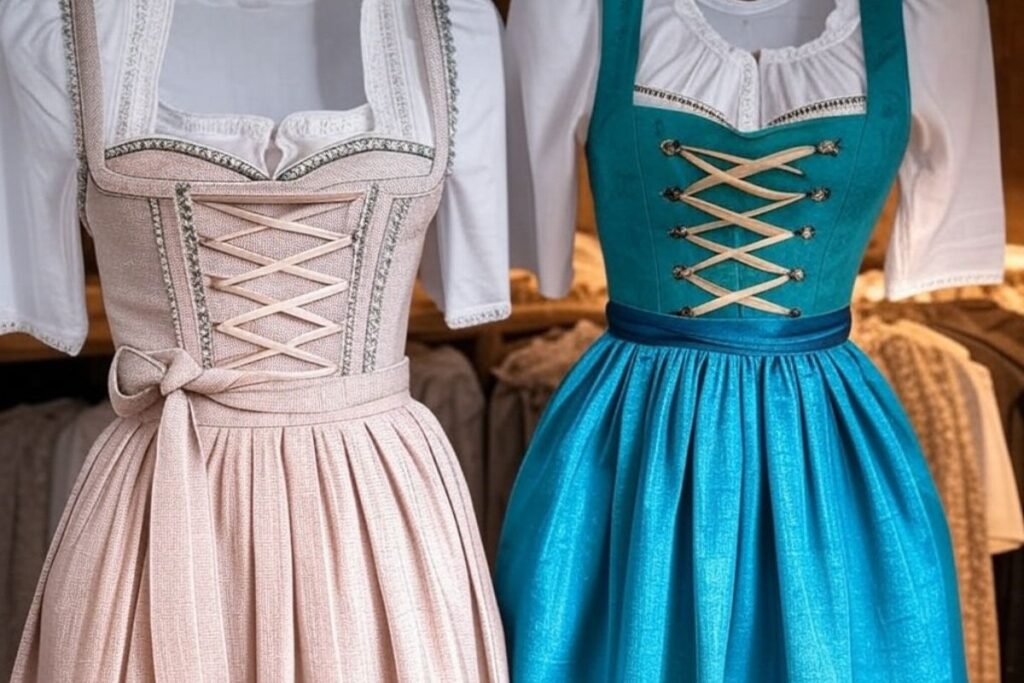
- Crisscross Lacing: This is the classic, corset-inspired look you’ll see on many traditional dirndls. The ribbon or chain is woven over and under in an X pattern from top to bottom. It gives a strong visual structure and allows for controlled tightness throughout the bodice.
- Inside-Out Lacing: Less common but no less authentic, this method hides more of the ribbon and creates a subtler effect. The lacing goes from inside one eyelet to the next, creating a smoother front. It’s perfect for when you want the focus to be on the dress rather than the lace.
Use Ribbon or Chain — Match It to Your Dress Color
The lace you use should complement—not clash with—your dirndl. Most dirndls include a matching ribbon, but some styles give you the option of using a metal chain for a bolder, more festive look. Here’s how to choose:
- Ribbon Lacing: Soft and flexible, ribbons come in satin, velvet, or grosgrain. These are perfect for a feminine, romantic vibe. If your dirndl has floral embroidery or soft color tones, a matching ribbon is ideal.
- Chain Lacing: More structured and eye-catching, chains (especially silver or bronze) pair well with darker or more formal dirndls. These are often used during Oktoberfest or nighttime events where a little extra sparkle goes a long way.
Tie the Apron
From where you tie your bow to how neatly it’s aligned with your skirt, each detail plays a meaningful role. Let’s break it down:
Apron Bow Placement Guide
The position of your apron bow speaks volumes—especially at traditional Bavarian events like Oktoberfest. Here’s what each placement means:
- Left Side — Single and Ready to Mingle
Tying your dirndl apron on the left side signals that you’re single and potentially open to meeting someone. This placement has become a widely recognized indicator in social settings and can often spark friendly conversation. - Right Side — In a Relationship
If your bow sits on the right, it shows that you’re taken, whether that means married, engaged, or in a committed relationship. It’s a polite and respectful way to let others know where your heart is. - Center — Virgin or Traditional Maiden
A bow tied at the center front typically suggests that you’re a virgin or adhering to traditional customs. Though less commonly seen today, it still holds ceremonial value, especially during parades or heritage celebrations. - Back — Widow or Working (Waitress/Server)
A bow tied at the back can have dual meanings: either you are a widow, or you’re working as a waitress at the event. In many venues, staff members use this placement as part of their uniform etiquette.
Understanding these symbolic placements helps you engage with Bavarian traditions respectfully—and lets your apron do the talking before you even say “Prost!”
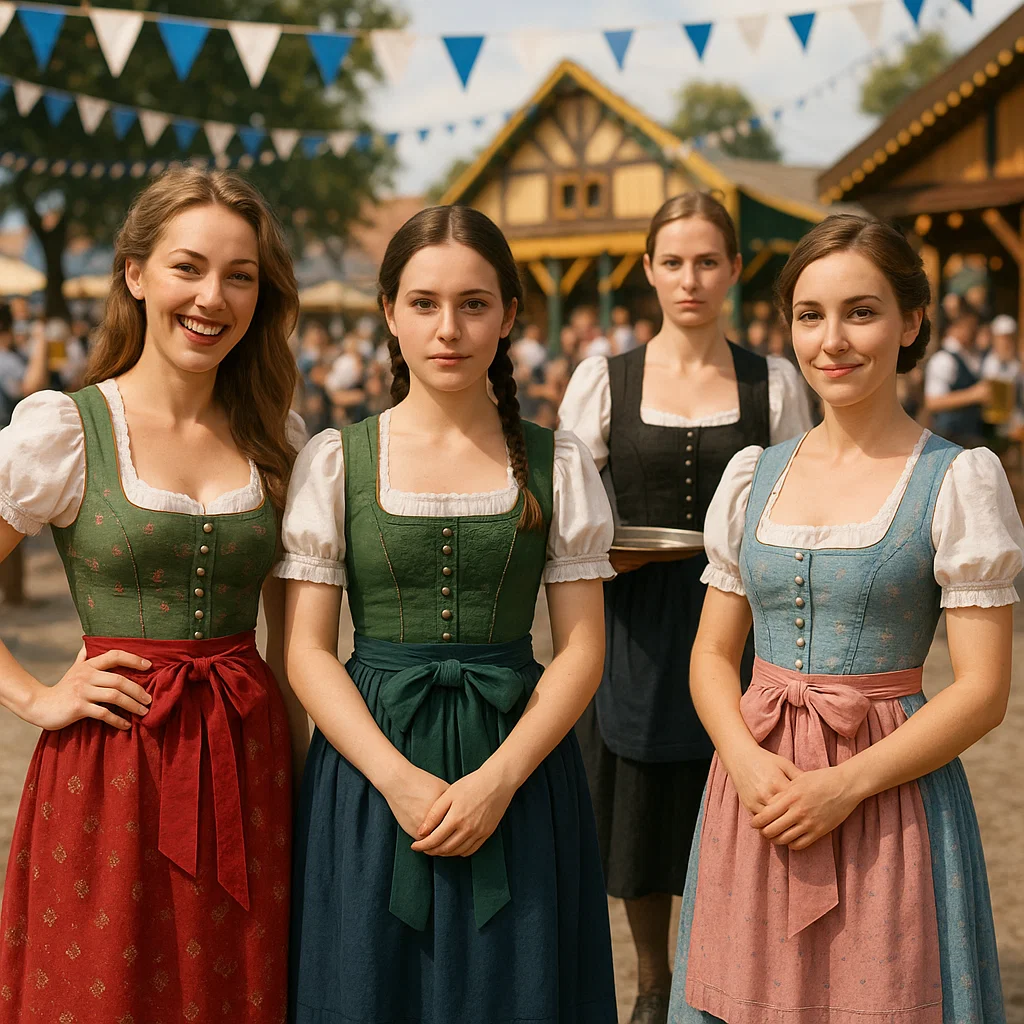
Tips on Tying the Perfect Bow and Aligning the Apron Length with the Skirt
It’s not just where you tie your bow—it’s also how you tie it. A well-tied bow and properly placed apron enhance the overall polish of your outfit. Here’s how to get it just right:
- Perfecting the Bow:
Choose a ribbon or apron tie that complements your dress in texture, length, and color. When tying the bow, aim for a symmetrical, neatly cinched loop that rests just above the hip. Avoid oversized, floppy bows—they can throw off the outfit’s balance. Think crisp, chic, and securely knotted. - Apron and Skirt Alignment:
Your apron should match or slightly overlap the skirt length—never fall significantly shorter or longer. A mismatched hemline can distract from the classic silhouette of the dirndl.- For knee-length dirndls, keep the apron at or just above the hemline.
- For midi or long dirndls, ensure the apron flows naturally with the skirt, without bunching or pulling.
- Securing the Apron:
Make sure your apron is tight enough to stay in place but not so snug that it pulls the bodice fabric. Use the waist seam as your guide to center the apron, ensuring it lays flat across your front.
Optional Add-Ons for Style
Once your dirndl is perfectly fitted, laced, and bowed, it’s time to take your look to the next level with optional add-ons that celebrate tradition and showcase your personal flair. These accessories and beauty touches aren’t required—but they can make all the difference.
Choker, Floral Hairpin, or Shawl
Bavarian-inspired accessories elevate the elegance of a dirndl while keeping the look rooted in authenticity.
- Choker Necklace:
A velvet or satin choker with a small charm (like an edelweiss flower, heart, or crystal pendant) is a time-honored dirndl accessory. It highlights the neckline and pairs beautifully with dirndl blouses that have low-cut or sweetheart designs. - Floral Hairpin or Crown:
Add a touch of nature with a single floral hairpin or go bold with a flower crown. Whether real or faux, flowers add femininity and celebrate Alpine traditions, where flower accents are common in festivals and folk weddings. - Lace Shawl or Lightweight Wrap:
Especially for cooler evenings or formal occasions, a delicate lace shawl draped over the shoulders adds grace without covering up the dirndl too much. Choose neutral or pastel tones that complement your dress, not clash with it.
These accessories aren’t just aesthetic—they reflect the heritage, romance, and femininity deeply woven into dirndl culture.
Light Makeup, Braids, or Bun for Authenticity
Beauty styling can subtly enhance your look without feeling too modern or overdone. Aim for a balance between timeless charm and fresh-faced elegance.
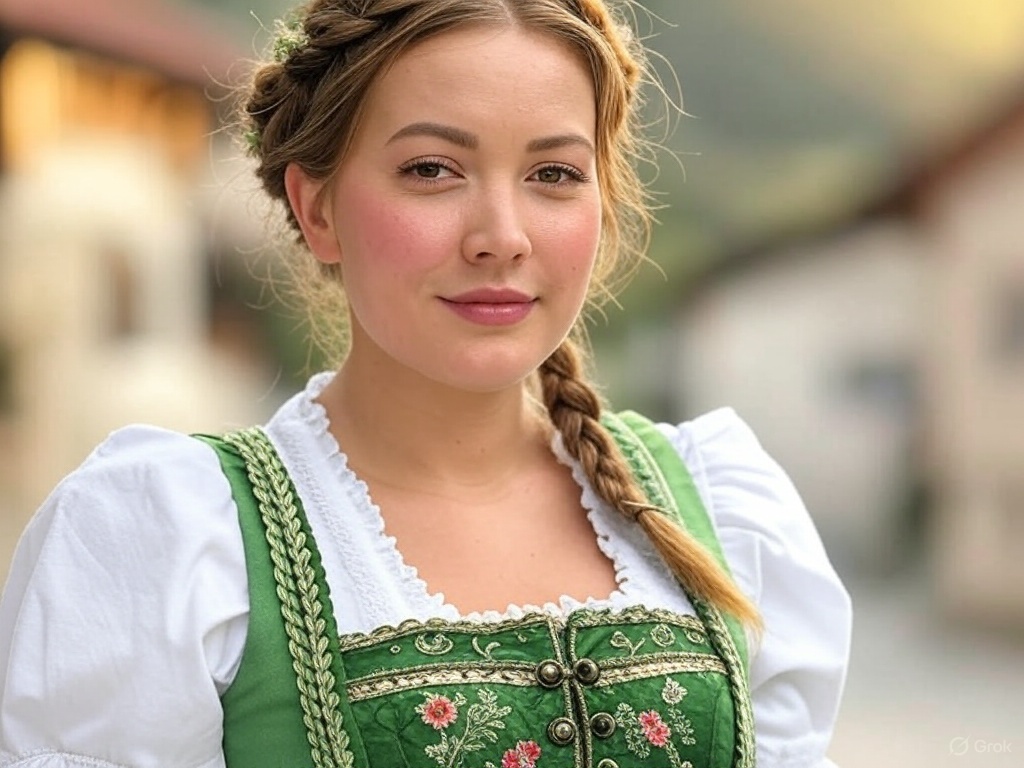
- Makeup:
Keep it light and natural. Think rosy cheeks, a soft pink or berry lip, and defined but gentle eye makeup. The goal is to look glowing and effortlessly graceful, not heavily made up. - Braids:
Braids are a classic hairstyle in Germanic and Alpine regions—ideal for Oktoberfest and dirndl events. Options include a crown braid, side braid, or braided bun. These styles keep your hair neat, functional, and totally on-theme. - Low Bun or Twists:
If you’re going for a more refined or mature look, opt for a low bun at the nape or soft twisted styles pinned to the side. These pair wonderfully with chokers and shawls, and highlight any neckline detail on your dirndl.
These finishing touches help you stand out not just for the outfit you wear, but for how beautifully you wear it.
Shop Your Look at German Attire
Ready to complete your ensemble? At German Attire, you’ll find everything you need to bring your dirndl or lederhosen look to life. From delicately embroidered dirndl blouses to full Dirndl sets and authentic Lederhosen, each piece is crafted with traditional charm and modern comfort in mind. Whether you’re preparing for Oktoberfest or a themed celebration, explore our curated collection to style your outfit with confidence and cultural flair.

Anna Bauer is a seasoned Bavarian fashion expert, cultural consultant, and heritage stylist with over a decade of hands-on experience in traditional German clothing. Born in Munich, the heart of Bavaria, Anna grew up surrounded by the rich traditions of Trachten fashion. Her passion for cultural attire led her to pursue a degree in Fashion and Textile Design at the prestigious University of the Arts Berlin, where she specialized in European folkwear.
Over the past 12+ years, Anna has collaborated with renowned Trachten designers, styled outfits for Oktoberfest events across Germany, and contributed articles to top fashion and culture magazines across Europe. Her work focuses on preserving the authenticity of Lederhosen and Dirndl wear while helping modern audiences style them with confidence and flair.
As the lead content contributor for German Attire, Anna combines her academic background, professional styling experience, and deep cultural roots to provide readers with valuable insights into traditional German fashion. Her blog posts cover everything from historical origins and styling guides to care tips and festival outfit planning—making her a trusted voice for anyone looking to embrace Bavarian heritage in a stylish, modern way.
